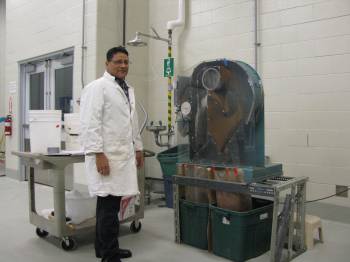
NEWS HIGHLIGHT
Targeted DDGS Fractions for Poultry Possible
Research has shown wheat distillers dried grain with solubles (DDGS), the main co-product of Prairie ethanol production, can have good feeding value for livestock when dried properly.

|
|
| Using simple size, density and weight separation equipment Dr. Fernando Hernandez with Alberta Agriculture produced high protein and low fibre fractions from wheat DDGS for feeding to poultry and swine. With little investment, existing ethanol plants could scale-up this technology to differentiate their DDGS as a plant back-end process instead of altering their current methods. |
April 16, 2010 – Research has
shown wheat distillers dried grain with solubles (DDGS), the main
co-product of Prairie ethanol production, can have good feeding value
for livestock when dried properly. Eduardo Beltranena, feed research
scientist with Alberta Agriculture and Rural Development, says existing
ethanol plants can make this possible with little investment.
“During ethanol production, the starch in wheat grain is broken down and the sugars fermented to ethanol for mixing with gasoline. Because of the starch conversion to ethanol, the remaining protein and fibre concentrate about three times in DDGS compared to wheat grain,” says Beltranena.
According to Beltranena, as long as the DDGS are gently dried and not scorched, the protein in wheat DDGS (38 to 40 per cent) has good feeding value for livestock. However, the high fibre content of DDGS (35 per cent) limits its nutrient utilization by monogastric animals, which don’t have a rumen full of bacteria to digest the fibre like cattle do.
Beltranena says Alberta Agriculture and Rural Development has come up with a low cost, environmentally friendly way of enriching the protein and reducing the fibre, increasing monogastric utilization of DDGS. “Using readily available particle size and weight separation equipment we produced fractions ranging from 29 per cent protein and 37 per cent fibre for ruminants to 49 per cent protein, but only 18 per cent total dietary fibre for monogastric animals,” he says.
Keeping in mind that prairie ethanol plants have already been built and are unlikely to modify their processes, Beltranena says existing plants can scale-up their technology to differentiate their DDGS as a plant back-end process instead of changing their processing.
“Having species-targeted DDGS would increase use of this ethanol co-product by more animal species than just cattle, and diversify the market opportunity for the ample supply of prairie wheat DDGS.”
Fractions feeding trials are now being tested on broilers, trout and growing pigs, in collaboration with the University of Saskatchewan and the University of Alberta.
Print this page